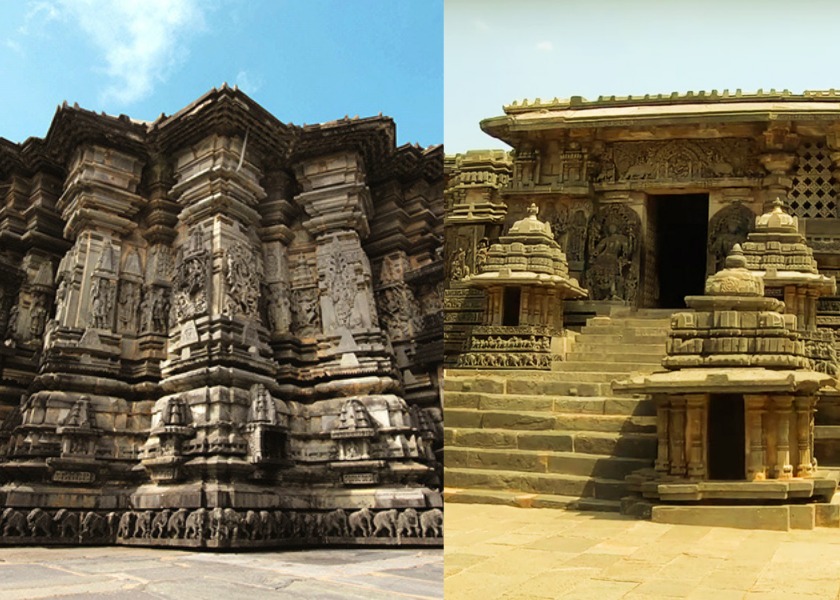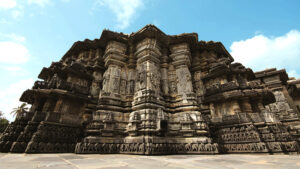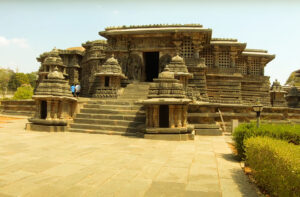Karnataka excited about Hoysala Temples World Heritage nomination

Hoysala Temples in Belur, Somnathapura and Halebid officially nominated by India for UNESCO World Heritage List (Photo: Karnataka Tourism)
Karnataka Tourism is very excited about the recent nomination of the three Hoysala Temples for the UNESCO World Heritage list as officials say that the nomination, if successful, would lead to a sharp increase in both domestic and international tourists to the state.
“These three temples of the Hoysalan architecture are amongst the best examples of the stone carvings that we have in the country. They definitely deserve to be on the list and we are happy that they are getting considered this time at least. If you get featured on a UNESCO List, you will generally get more people who endorse travellers who travel based on these world sites. That crowd will automatically be generated and along with this we already have three sites in the state: Hampi, Pattadakal and the Western Ghats, which already attract a lot of people. And, we also expect that the same crowd will again visit the sites,” Sindhu B Rupesh, Director, Tourism, Government of Karnataka, tells Media India Group.
“Statistically also we have seen that usually, this sort of crowd doubles over time when you have more such sites. We hope that when the international travel open ups, more influx takes place not just in the state but definitely to the state and to the country as well. Other than the three temples which were included in the list, Karnataka is a cradle for stone architecture. There are many festivals including Dussehra which is almost 400 years old. We have a lot of things but we want to take it one step after the other we are working towards this now presently and we are happy that it has reached this state,” observes Rupesh.
Not just the government, but tourism stakeholders like tour oeprators are also thrilled by the development. S Mahalingaiah, Director of Skyway International Travels & Secretary, Karnataka Tourism Society, agreeing with Rupesh says, “We have been demanding that the temples which are one of the prime examples of sculpture architecture be included into the UNESCO World Heritage List for over 5 years. There are already three sites in the list from Karnataka now, three more will be added to the list.”
Mahalingaiah believes this is a good initiative by the government to improve tourism into the country and state. “Around 1.2 to 2. million tourists, including both domestic and international visitors, come to the Kesava temple each year. As and when new sites are added to the UNESCO lists, promotion and marketing is also enhanced to promote the destination on the international level. We also have witnessed that when such initiatives are taken by the government then the tourism at the destination doubles over time. There are travellers who travel only to witness the heritage and culture the area has to offer. The numbers of such kinds of tourists are bound to double,” observes Mahalingaiah.
Since the onset of Covid-19 pandemic, travel and tourism industry, one of the most important revenue generating sectors for any country or state bore the brunt of the travel restrictions owing to health precautions. The Department of Tourism, Karnataka believes that this will help in improving the suppressed socio-economic conditions of the state due to the pandemic by improving the number of inbound travellers to the state.
“The inclusion of more sites from Karnataka to the UNESCO list shall bring significant international attention and recognition which shall provide greater support the preservation and conservation of these heritage sites of Karnataka. The presence of such sites attracts significant international tourists visit which in turn is leads to socio-economic benefits to the local area and host State and Country. The Karnataka Tourism Policy 2020-26 envisions positioning Karnataka as the most preferred tourism destination for tourists across the world. The presence of a UNESCO World Heritage Sites strengthens Karnataka’s position in this regard and attracts tourists with the promise of a memorable and world-class experience,” Pankaj Pandey, Secretary to Department of Tourism, Government of Karnataka tells Media India Group.
“Karnataka has witnessed a steady increase in Foreign Tourist Arrival (FTA) in the years prior to the Covid-19 pandemic. 543,000 foreign tourists visited Karnataka in 2018 with a growth of 9.1 pc compared to 2017. The foreign tourist visits to Karnataka rose to 608,000 in 2019 with a growth of 12 pc compared to 2018. In the backdrop of the pandemic, the FTAs to Karnataka in 2020 was 165,325. As tourism adapts to a new normal, it remains to be seen how the global tourism sector recovers. Karnataka’s wealth of tourism offerings and its promise of “One State, Many Worlds” is sure to attract many tourists to the State and the Government of Karnataka has undertaken a variety of measures to support the survival and revival of the State’s tourism sector,” adds Pandey.
The ‘Sacred Ensembles of the Hoysala’ had been on UNESCO’s tentative list for over 8 years, but on January 31, India formally submitted the names of the temples built by the ancient dynasty in Belur, Halebid and Somnathpura as its official nomination for the UNESCO World Heritage List.
The Hoysala empire (11th – 14th century) ruled in the southern Deccan region and the Kaveri River Valley. During its rule, the dynasty built over 1500 temples in their territory. However, over the years only 100 have survived the test of time.
“India is proud to nominate The Sacred Ensembles of the Hoysalas for UNESCO’s World Heritage List! Art historians recognise the exceptional sculptural artistry of the ensembles to be among the masterpieces of Asian art,” Vishal V Sharma, Permanent Representative of India to UNESCO, tweeted after submitting the dossier to Lazare Eloundou, UNESCO Director of World Heritage.
While the dossier will be considered later this year, UNESCO will subsequently conduct the site evaluation. As per the Ministry of Culture, the three temples fall under the Archaeological Survey of India and their maintenance and conservation will be the responsibility of the state.
Why Hoysala temples has been nominated?
The creator of the temples, Hoysala Dynasty rules in the Deccan Plateau of Southern India. The capital of the empire initially resided at Belur and later moved to Halebidu.
The Hoyasala rulers lived in the hills, northwest of Dorasamudra situated in the Western Ghats range. In the 12th century, taking advantage of the internecine warfare between the ruling Chalukya and Kalachuri kingdoms, the Hoysalas annexed the areas of present-day Karnataka and the fertile regions of North of the Kaveri River delta in present-day Tamil Nadu and parts of western Andhra Pradesh in Deccan India.
The ruling era of the Hoysala dynasty emerged as an important period in the South as it contributed greatly to the development of art, architecture and religion there. The empire is primarily remembered to this day for its architecture especially of its temples.
Chennakeshava Temple

Chennakeshava Temple in Belur is one of the prime examples of stone carvings and is one of the nominee for UNESCO World Heritage List (Phoro: Karnataka Tourism)
The Chennakeshava temple devoted to Vishnu, situated in Belur approximately 155 km from the city of Mysore is highly sculptured on the outside with scenes from the daily, life, music and the epic tales of Mahabharata and Ramayana. Apart from that, depictions of Shiva are also present at the temple.
The temple is situated in the city of Belur, one of the first capital cities of the kingdom. The temples themselves were located at the centre of the old walled town located on the banks of the Yagachi River. Its construction started in 1117 AD and took 103 years to complete. A total of 118 stone inscriptions have been recovered from the temple from a period from 1117 to the 18th century, providing details of the artists employed, along with the grants made to the temples and renovations done in the ancient times.
Hoysaleshwar Temple

Hoysaleshwar Temple in Halebid is another nominee for the UNESCO World Heritage List (Photo: Karnataka Tourism)
The Hoysaleshwara temple at Halebid or Halebidu dedicated to the Shiva was built in 1121CE during the reign of Vishnuvardhana Hoysaleshwara. The temple was sponsored and built by the wealthy citizens and merchants of Dorasamudra. Its construction began in the 12th century by the King of Hoysala. It was, however, looted in the 14th century and it fell into ruins after that.
The temple, despite being looted, is one of the most exemplary architectural examples in the country and is located about 150 km from the Mysore. Hoysaleshwar temple is more sculpturally rich and sophisticated than other temples built by the dynasty. There are more than 240 wall sculptures that run all along the outer wall with intricately carved friezes running along the exterior wall expressing spiritual qualities, symbolism and mythology.
Kesava Temple
The Kesava Temple, dedicated to Krishna, is one of the seven incarnations of Vishnu. It is dedicated to three forms of Krishna – Janardhana, Kesava and Venugopala. The construction of the temple was completed and consecrated in 1268AD. It was constructed by one of the commanders in the Hoysala Army named Somnatha. The general also established a small town here named after himself, Somanathapura.
With the temple being dedicated to the three forms of Krishna, the idol of Janardhana is missing while the rest of the idols are damaged. The temple situated 38 km from the city of Mysore has three shrines and Vimanas. The walls are also covered in beautiful friezes of the scenes from the epics, figures of elephants and battle scenes depicting cavalry. Apart from the walls the ceilings also contain beautiful decorations.









